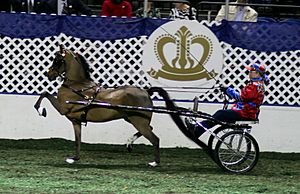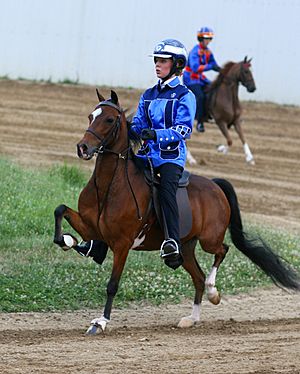Hackney pony facts for kids

Hackney pony and 2007 Horse of the Year nominee, Free Willy, in Road Pony competition
|
|
| Distinguishing features | Fine, slim, well-proportioned body; long, arched neck; set tail; animated and exaggerated motion |
|---|---|
| Country of origin | England |
| Common nicknames | "Aristocrat of the Show Ring" |
| Horse (Equus ferus caballus) | |
The Hackney pony is a special pony breed. It is very closely related to the Hackney horse. Long ago, people bred them to pull carriages. Today, these ponies are mostly used as amazing show ponies. The Hackney pony does not have its own special record book. Instead, it shares one with the Hackney horse in all countries that have an official Hackney Stud Book Registry.
Contents
History
The Hackney Pony was first created by a person named Christopher Wilson. He used a Hackney horse stallion named Sir George, born in 1866. Sir George was bred with Fell pony mares. Then, their offspring were bred together to make a new, fixed type of pony.
Christopher Wilson wanted to create a true pony, not just a tiny horse. He wanted to give this pony the big, high trot and other features of the Hackney horse. He succeeded in making the pony he wanted. This is a rare example of a whole breed being created in a controlled, private way. The Hackney Pony likely also has a lot of Welsh Pony blood.
These ponies were first called Wilson Ponies. They often stayed outside all year, even in harsh winters. They lived in the tough Fells with little food or care. This helped the breed become very tough and strong. By the 1880s, the breed was well-known. People loved them for their great trotting ability and style.
Hackney ponies were used in Great Britain to pull carriages. They were also brought to the United States. In the late 1800s and early 1900s, before cars were common, they were very stylish for driving. After cars replaced horses for travel, many horse breeds, including Hackney ponies, became less popular. Their numbers dropped a lot.
However, after World War II, the Hackney pony became popular again. It was developed mainly as a show pony. Today, they are still bred for this purpose. This stopped their numbers from dropping, and the breed became well-known once more.
Many Hackney pony breeders today still work to create beautiful, high-quality ponies. In the United States, Hackney ponies have also influenced the American Shetland pony. They were bred with Shetlands to create the American Shetland show pony we see today. This type of Shetland shows many of the refined features of the Hackney pony. The Hackney has also influenced the miniature horse, making them more refined and active.
Characteristics
General appearance
A Hackney pony cannot be taller than 14.2 hands (58 inches, 147 cm) hands (about 58 inches). They usually stand between 12 and 14 hands tall. They should look like true ponies, not just smaller versions of Hackney horses. The pony should have a small head, held high. Its ears should be alert and pricked, and its eyes large and smart.
The neck should be strong, arched, and carried proudly. Hackney ponies should have powerful shoulders and a compact back. Their body should be light. Their legs are strong with good joints, but the bones are usually fine. Their feet are very hard. Their hooves are often allowed to grow long at the toe. This makes their high leg action even more noticeable. The tail is often set high and carried proudly.
Hackney ponies usually have even more exaggerated action than Hackney horses. Their knees rise as high as possible. Their hocks (back leg joints) come right under their body. Their movement should be smooth, amazing, and full of energy.
Colors
Hackney ponies can be black, bay (which includes brown), or chestnut. Bay is the most common color, and black is also quite common. Chestnuts, however, are very rare. Their color is usually light, and chestnut ponies often have flaxen (light-colored) manes and tails.
Many Hackneys also have some white markings. This is due to the sabino gene, which is common in the breed. The Hackney Pony may have white marks on its body, legs, and head. The sabino gene is often unpredictable. So, breeding only for white body marks can be tricky.
Temperament
The Hackney Pony is known for being determined and brave. These are important qualities for top show ponies. They are very courageous, alert, and active. They also have great stamina (endurance). Generally, they have a typical pony personality. Hackneys are known for being friendly towards people. They are good for both shows and as companion animals.
Show Types
In horse shows, the Hackney pony is most often seen being driven in a harness. They are also shown under saddle, usually as road ponies. Sometimes, they are shown in hand as young weanlings or yearlings.
The Hackney pony show division has six main categories for harness driving. These are Hackney Pony (cob tail), Harness Pony, Hackney Roadster, Park Pleasure Driving, Show Pleasure Driving, and Country Pleasure Driving. Their biggest championship is the Kentucky State Fair World's Championship Horse Show in Louisville, Kentucky. Their national championship is the American Royal in Kansas City, Missouri.
Most classes require a “Park Trot.” This is a very collected (controlled) way of trotting. Then, judges tell exhibitors to “Show your pony.” This means they can speed up to show off their pony's best qualities. Going too fast is not good and will be penalized.
Hackney roadster
Hackney roadsters, also called Road ponies, are shown pulling a two-wheel bike, or sulky. The driver always wears special racing silks. These silks usually show the colors of their barn or stable. Road ponies are judged on how they trot, their speed, their body shape, and their personality.
Besides being shown with a bike, road ponies are also shown under saddle by younger riders. They can also be hitched to a four-wheel wagon. Wagon classes are newer but are becoming more popular. The World's Championship Horse Show had a wagon class for the first time in 2006.
Hackney (cobtail) ponies
In the Cobtail pony division, ponies have a tightly braided mane. Their tail looks like it has been docked (cut short). However, it is usually just trimmed short, not actually docked. These ponies are generally taller. Any height of pony can show in this division, as long as it is still a pony (not over 14.2 hands).
Harness ponies
Harness ponies are often seen as the most elegant Hackney ponies. For road ponies, speed is very important. But harness ponies should be more collected. They show a very lively and airy trot. A Hackney must be smaller to show in the harness pony division. They must be 12.2 hands (50 inches, 127 cm) hands or under. They are shown pulling a four-wheel viceroy carriage and have a full mane and tail. Drivers usually wear a suit for men or a dress for women.
Pleasure ponies
There are also three pleasure driving classes for the breed: Park Pleasure, Show Pleasure, and Country Pleasure. There are no height rules, except that the Hackney must be a pony. The pony can have a long or a short (docked) tail. Pleasure ponies are shown pulling a two-wheeled cart. The driver usually wears more casual clothes. They are shown at a road gait, pleasure trot, and flat walk. Their personality is very important to the judges. A pleasure pony should truly be a pleasure to drive.




